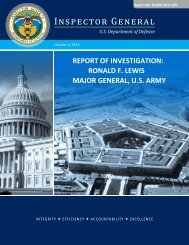Command Red Team
2gWzzvB
2gWzzvB
You also want an ePaper? Increase the reach of your titles
YUMPU automatically turns print PDFs into web optimized ePapers that Google loves.
CHAPTER III<br />
RED TEAM CHALLENGES<br />
“[An] Important reason to consider alternatives involves the fact that analysts<br />
do not process information entirely ‘objectively’ because of biases in human<br />
perception and judgment.”<br />
“Making Sense of Transnational Threats”<br />
by Warren Fishbein and Gregory Treverton<br />
The Sherman Kent Center for Intelligence Analysis Occasional Papers<br />
Volume 3, Number 1, October 2004<br />
1. Overview<br />
a. The red team must understand not only the external OE but also the<br />
organizational culture of its parent command.<br />
b. Most of the internal issues that concern the red team derive from the fact that staff<br />
officers are human and staffs are social groups. Many of the subjective cognitive<br />
processes that can hinder analysis and decision making by individual staff officers can<br />
also be manifested by groups of individuals or staffs.<br />
2. Two Environments<br />
a. <strong>Command</strong>ers, planners, operators, and intelligence analysts consider the OE when<br />
assessing situations and developing military options. The red team assesses the same<br />
political, military, economic, social, information, infrastructure, physical, and time<br />
factors as the rest of the staff, but with the specific objective of developing alternative<br />
perspectives and interpretations or ones that challenge their assumptions regarding the<br />
environment.<br />
b. The red team not only needs to understand the problem the staff is<br />
considering, but it also needs to understand two environments: the individual’s<br />
cognitive environment and the organizational culture of the staff. Understanding<br />
these two environments is a necessary prerequisite to the red team’s task of stimulating<br />
critical and creative thought and countering the influence of organizational constraints<br />
that might sway, constrain, or prejudice the staff’s thinking.<br />
c. The internal issues that the red team addresses are inherent to all organizations.<br />
They are the natural, unavoidable consequences of the fact that staff officers are human,<br />
staff agencies are human social groups, and problem solving involves cognitive human<br />
processes. Conscientious staff officers will take affirmative steps to minimize the<br />
potential for these factors to constrain thinking and inhibit analysis. However, even the<br />
most diligent officers can be too close to a problem to see their own hidden assumptions<br />
and biases. As a primary task, the red team is expected to use its independent perspective<br />
and special training to help the staff counter these hidden assumptions and biases.<br />
III-1



